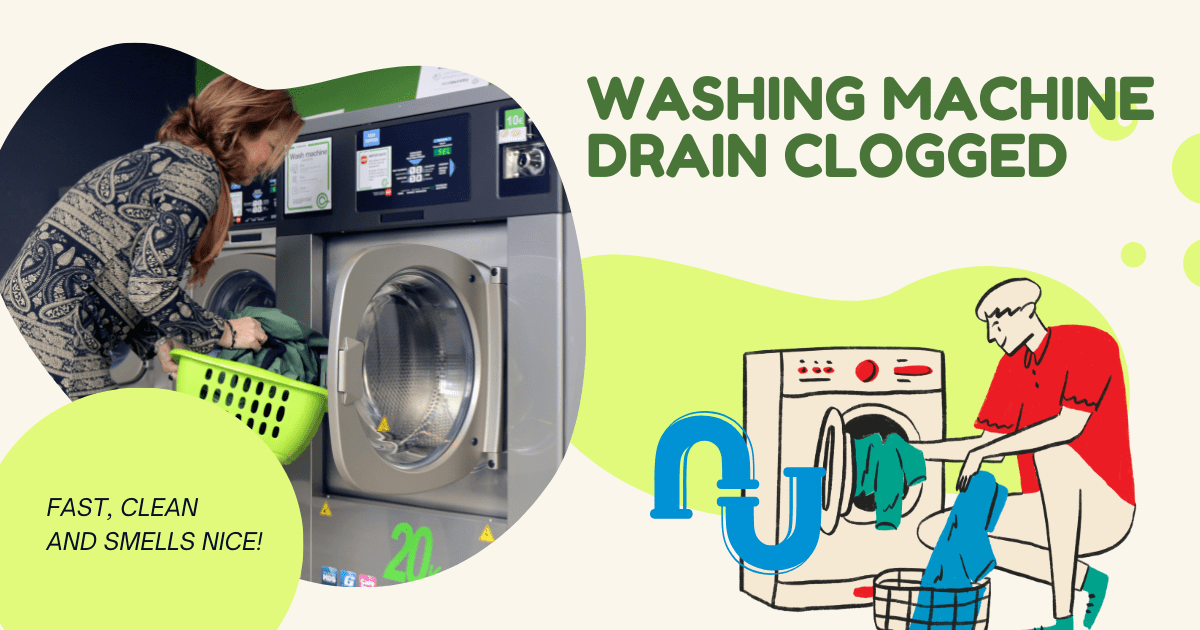A washing machine drain clogged can be a real headache. It happens when lint, soap scum, or debris build up in the drain pipe. This blockage prevents water from flowing out properly during the wash cycle. As a result, you might see water backing up in the machine or on the floor. Fixing a clogged drain often involves cleaning the hose and removing any obstructions.
Is your laundry day turning into a watery nightmare? Don’t panic! A clogged washing machine drain is a common household hiccup. But fear not—we’ve got five simple tricks to get your washer flowing smoothly again. Say goodbye to standing water and hello to fresh, clean clothes!
Dealing with a clogged washing machine drain can be frustrating. Luckily, there are several easy fixes you can try at home. First, check the drain hose for kinks or blockages. You can also use a plumber’s snake or a baking soda and vinegar mixture to clear the clog.
Signs of a Clogged Washer Drain

Signs of a clogged washer drain are often easy to spot. You might notice water pooling around your machine during or after a cycle. Clothes may come out soaking wet, even after the spin cycle. Strange gurgling noises from the drain are another red flag. You might also see soap residue or lint buildup in the drum. These signs usually mean it’s time to check your washer’s drain.
Slow draining is another common symptom of a clog. Your machine might take much longer than usual to empty. In some cases, you’ll see dirty water backing up into the washer tub. Unpleasant odors coming from the washer can indicate stagnant water in the pipes. If your washing machine stops mid-cycle, it could be because it can’t drain properly. Don’t ignore these signs, as they can lead to bigger problems if left unchecked.
Oh no! The washing machine drain clogged. What should I do?
Oh no! A clogged washer drain can mess up laundry day. Don’t worry, though—there are some easy fixes you can try. First, check the drain hose for any visible kinks or blockages. Sometimes, just straightening out the hose can solve the problem. If that doesn’t work, try unplugging the washer and removing the hose. You might find a clump of lint or small items causing the clog.
If the hose looks clear, the problem might be deeper in the drain pipe. You can try using a plumber’s snake to reach further down. Another option is to pour a mixture of baking soda and vinegar down the drain, followed by hot water. This can help break up stubborn clogs. If these DIY methods don’t work, it might be time to call a professional plumber. They have specialized tools to tackle tough clogs.
Solving a washing Machine drain clogged

Solving a clogged drain doesn’t have to be a nightmare. Start by pouring boiling water down the drain to loosen any buildup. If that doesn’t work, try using a plunger to create suction and dissolve the clog. For tougher clogs, a mixture of baking soda and vinegar can work wonders. Let it sit for about 30 minutes before flushing with hot water. If these methods fail, a drain snake can help reach deeper clogs.
Chemical drain cleaners are an option, but use them sparingly. They can damage pipes if used too often. For persistent clogs, consider removing and cleaning the P-trap under the sink. This U-shaped pipe often catches debris and is easy to access. Remember to place a bucket underneath to catch any water. If you’re still struggling, it might be time to call a professional plumber.
Tip 1: Clean the trap
The trap is a crucial part of your washing machine’s drainage system. It catches small items and lint to prevent clogs. To clean it, locate the trap door on your machine’s front or back. Open it carefully, remove any debris, and rinse the trap thoroughly before replacing it.
Tip 2: Pour boiling water and baking soda down the drain.
Boiling water and baking soda can work wonders on a clogged drain. Start by pouring a pot of boiling water down the drain. Then, add half a cup of baking soda and let it sit for a few minutes. Finally, flush with more boiling water. This simple method often breaks up minor clogs and freshens your drain.
Best Tips about Washing Machine Drain Clogged
Tip 3: unclog with a drain snake
A drain snake is a handy tool for fixing clogs. It’s a long, flexible wire that you push into the drain. Twist the snake to grab the clog and pull it out. This method works well for tough blockages that plungers can’t fix.
Tip 4: Use a drain unblocker.
Drain unblocker can fix slow drains fast. Pour it down the sink or shower drain. Follow the instructions on the bottle carefully. It breaks up clogs and gets water flowing again.
Tip 5: Rinse it with a high-pressure cleaner.
Be careful when using a high-pressure cleaner on your iPhone case. It can be too strong and might damage your case. Only use this method if your case is very dirty and tough. Hold the cleaner far away from the case at first. Start with a low setting and test it on a small spot before cleaning the whole case.
Steps to clear a clogged washer drain
Here are some steps about washing machine drain clogged
Step 1: Turn off the power.
Unplug your washer from the wall outlet. This keeps you safe while you work. It also stops water from pumping if the washer turns on by accident.
Step 2: Find the drain pipe.
Look behind your washer for the drain pipe. It’s usually a large, flexible hose. Make sure you can reach it easily before you start working.
Step 3: Check for blockages.
Take the pipe off the drain. Look inside for any obvious clogs. You might see lint, coins, or small items stuck inside. Remove anything you can reach with your fingers.
Step 4: Plumber’s snake
Get a plumber’s snake or auger if you have one. Feed it into the drain pipe slowly. Push it through until you feel resistance. Turn the handle to break up the clog you’ve found.
Step 5: Hot water and vinegar
Try hot water and vinegar. Mix equal parts hot water and white vinegar in a bucket. Pour this mixture down the drain carefully. Let it sit for about 15 minutes. This can help dissolve soap scum and small clogs.
Step 6: Power on
Power on the washer. Plug your washer back in when you’re done. Run an empty cycle with hot water. This helps flush out any remaining debris. Check for leaks around the drain pipe as it runs.
Step 7: Call a top-rated plumber

Call a top-rated plumber if needed. If these steps don’t work, it’s time to call a pro. Plumbers have special tools for tough clogs. A professional can also check for bigger problems. It’s better to get help than risk damaging your washer or pipes.
DIY methods to unclog the washer drain
There are some easy ways to unclog your washer drain at home. First, try using a plunger to push out the clog. Fill the washer with warm water and plunge the drain opening. You can also make a mixture of baking soda and vinegar. Pour it down the drain and let it sit for an hour. Then flush with hot water to see if the clog is gone.
If those methods don’t work, try using a drain snake. Push it into the drain pipe and turn the handle to break up the clog. Another option is to use a wet/dry vacuum. Put the hose over the drain and turn it on to suck out the blockage. Remember always to unplug your washer before you start working on it. These DIY methods can often fix the problem without calling a plumber.
Best knowledge about washing machine drain clogged
Precautions to take before trying to unclog the drain
Before you start unclogging your washer drain, take some safety steps. First, unplug the washer from the wall. This keeps you safe from electric shocks. Put on some rubber gloves to protect your hands. Move the washer away from the wall if you can. This gives you more room to work. Have some old towels ready in case of spills.
Next, check what cleaning products you have. Don’t mix different cleaners. This can make dangerous fumes. Read the labels on any products you use. Keep kids and pets away from the area. Open a window to let fresh air in while you work. These simple steps can help you stay safe while fixing your drain.
Reasons for a Clogged Washer Drain

Washer drains can get clogged for many reasons. Lint is a common culprit. It builds up over time and blocks the pipe. Small items like coins or buttons can also cause trouble. They fall out of their pockets and get stuck. Soap scum is another problem. It sticks to the sides of pipes and narrows them.
Hair is a sneaky clog caused by washer drains. It wraps around other debris and makes big clumps. Grease from very dirty clothes can also build up. It coats the inside of pipes and traps other stuff. Sometimes, the drain pipe itself is the issue. It might be bent or damaged. This creates spots where things get stuck easily.
How to clean a washing machine drain hose without removing
Cleaning a washing machine Drain hoses don’t always require removal. Start by unplugging the machine and moving it away from the wall. Locate the drain hose and check for visible kinks or blockages. Pour a mixture of hot water and vinegar into the washer’s detergent dispenser. Run an empty cycle on the hottest setting to flush out the hose.
If the clog persists, try using a plumber’s snake. Insert it carefully into the drain hose opening. Gently push it through to break up any blockages. Once you feel resistance, twist the snake to catch the clog. Slowly pull it out, removing the debris. Finally, run another hot water cycle to ensure the hose is clear.
Conclusion:
Dealing with a clogged washing machine drain can be frustrating, but it’s often a fixable problem. From simple DIY methods like using boiling water and baking soda to more advanced techniques like snaking the drain, there are multiple ways to tackle the issue. Regular maintenance and being mindful of what goes into your washer can help prevent future clogs. Remember, if you’re unsure or the problem persists, it’s always best to consult a professional plumber.
Prevention is key when it comes to washer drain clogs. Use a lint trap, clean the filter regularly, and avoid washing clothes with items in the pockets. By following the tips we’ve discussed and staying proactive, you can keep your washing machine running smoothly and avoid the headache of unexpected clogs. With these tools in your arsenal, you’re well-equipped to handle most drain issues that come your way.
Best knowledge about washing machine drain clogged
FAQs:
How often should I clean my washing machine drain?
Clean your washer drain every 3–6 months to prevent buildup and clogs.
Can I use chemical drain cleaners on my washing machine drain?
It’s best to avoid harsh chemicals, as they can damage pipes. Try natural methods first.
When should I call a professional for a clogged washer drain?
Call a pro if DIY methods fail or if you suspect the clog is deep within the wall pipes.










